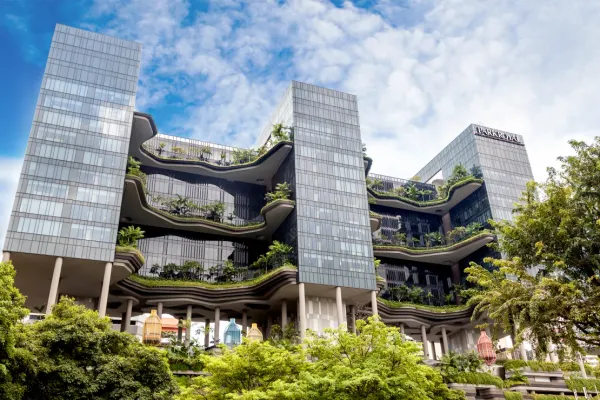Manifesto: Go Green Iniative

Architecture shapes our world in very many ways, it influences how we live, work, and the environment around us. As our world is continually getting more and more into a climate crisis, it is becoming our responsibility as world shapers, to go green in our building. We need to create sustainable, energy-efficient, and environmentally friendly structures as we move forward in the future.
In the past, traditional building methods were actually quite environmentally friendly because they would use things that are readily available to them to build and would adapt the design to their climate. However, as urbanization in our time is increasing day by day, it has become hard to maintain those practices. People are prioritizing building on as much land as they can to earn more money. High rise buildings and skyscrapers that emit carbon, and increase deforestation have become a norm. I want to talk about a few things that we can do to go green and turn the world that we are living in around.
On a more personal level, the houses that I have lived in as a child all had a backyard with lots of trees, but one house in particular stood out to me because it was inside a forest and majority of the trees were cut so that this house could be built instead of finding a way to build around them. This sparked my passion to advocate for going green. My manifesto will help upcoming architects build in an environmentally conscious approach. Let us go through the 3 goals we need to achieve by 2030, to be able to create a green built environment:
- Energy Efficiency
In most construction sites, equipment "usually pollutes the environment. This can be through excessive oil leaks, noise pollution, and CO2 emissions. In some construction sites, energy consumption accounts for up to 6% of the budget" (Lets Build, 2023). We must challenge this wasteful consumption and commit to using audited, energy-efficient equipment that minimizes environmental harm. Another key way to improve energy efficiency is by ensuring proper insulation. "Homeowners can save up to £490 on heating bills a year with wall insulation, according to the Energy Saving Trust" (Lets Build, 2023). Let us harness high-quality insulation and ventilation systems to make buildings as cost-effective and sustainable as possible.
- Sustainable Material Use
The materials we choose define our impact on the planet. According to McNamara in her article, “Going Green: Planning a Sustainable Facility Project,” "design teams can be more efficient with their materials by designing to standard product dimensions or using modular and prefabricated designs to reduce material usage" (McNamara, 2023). Prefabricated designs are one option, but we must go further. We must actively choose eco-friendly materials such as bamboo, reclaimed wood, and recycled steel to reduce waste. Let us build with intention, ensuring that every material choice reflects our commitment to a greener future.
- Integrate Nature in Design
Green spaces improve air quality, regulate temperature, and boost well-being. Features like green roofs, vertical gardens, and natural landscaping will add to the biodiversity in urban areas, bridging the gap between built environments and nature. Apart from that, they also "promote physical activity, social interaction, and relaxation, enhancing mental health and well-being" (Brears, 2024). By embedding nature into our designs, we do not just create better buildings but create better lives. Let us commit to reintroducing green spaces into urban landscapes, ensuring that every architectural project contributes to a more sustainable and livable world (Melet, 1999). The future of our cities depends on it, let's build with nature, not against it.
Sustainability is not an option, but a responsibility. Every structure we design and build shapes the world we leave behind. Let us choose to build a future where architecture coexists with nature, where design serves the environment, and where every space reflects our commitment to a green planet. The blueprint for change is in our hands, let’s make it happen!
Sources:
Brears, R. C. (2024, June 20). Greening the concrete jungle: How nature-based solutions can create sustainable and Healthy Cities. Medium. https://medium.com/mark-and-focus/greening-the-concrete-jungle-how-nature-based-solutions-can-create-sustainable-and-healthy-cities-26090d98b00b
Learn & Revise Editors. (2019, September 17). How do you make a city sustainable?. BBC Bitesize. https://www.bbc.co.uk/bitesize/articles/zdqt7nb
LetsBuild. (2023, December 22). Green Building Techniques: How You Can Make Your Construction Projects more environmentally friendly. Letsbuild. https://www.letsbuild.com/blog/green-building-techniques-how-you-can-make-your-construction-projects-more-environmentally-friendly
Mcnamara, E., Mcnamara, K., & Meyer, P. (2023). Going Green: Planning a Sustainable Facility. Facility Management Journal (FMJ), 33(2), 24–28.
Melet, E. (1999). Sustainable architecture : towards a diverse built environment / Ed Melet. NAI Publishers.




